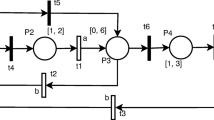Abstract
In this paper, a particular state model allowing describing the system evolution in time is proposed. This state model contains two inequalities describing the evolution in time of the system state and input. The system simulation is based on the resolution of this state model. After that, a state estimator is proposed in order to estimate the whole system state and inputs. The state model and the observer are both proposed following count and dater approaches successively. In this work, the considered state is the number of transition firing if a count approach is followed and the dates of firing if the dater approach is considered. It is proved, using an illustrative example, that the proposed observer estimates well the system state by comparing the simulated and the estimated states. A boundedness analysis of the system trajectory is proposed in the case of FCF Petri nets. This analysis is based on an algorithm which gives the bounded transitions knowing the system input. Some particular tables are elaborated to describe the proposed algorithm. Theses tables give the bounded transitions after each iteration of the algorithm.


Similar content being viewed by others
References
Al-Ajeli A, Bordbar B (2016) Fourier–Motzkin method for failure diagnosis in Petri net models of discrete event systems. In: WODES 16, Xi’an, China, May 30–June 1
Basile F, Cabasino MP, Seatzu C (2015) State estimation and fault diagnosis of labeled time Petri net systems with unobservable transitions. IEEE Trans Autom Control 60(4):997–1009
Bonhomme P (2013) State observer synthesis of real-time systems modeled by P-time Petri nets. In: 18th IEEE international conference on emerging technologies and factory automation
Boussif A, Ghazel M, Klai K (2018) Fault diagnosis of discrete-event systems based on the symbolic observation graph. Int J Crit Comput Based Syst 8(2):141–168. https://doi.org/10.1504/IJCCBS.2018.096178
Cabasino MP, Giua A, Seatzu C (2007) Marking estimation of Petri nets with arbitrary transition labeling. In: 1st IFAC workshop on dependable control of discrete systems, pp 109–114
Cabasino MP, Giua A, Seatzu C (2010) Fault detection for discrete event systems using Petri nets with unobservable transitions. Automatica 46(9):1531–1539
Cabasino M, Giua A, Pocci M, Seatzu C (2011) Discrete event diagnosis using labeled Petri nets. An application to manufacturing systems. Control Eng Pract 19(9):989–1001
Cabasino MP, Paola M, Hadjicostis CN, Christoforos N, Seatzu C (2015) Probabilistic marking estimation in labeled Petri nets. IEEE Trans Autom Control 60(2):528–533
Chouchane A, Declerck P, Khedher A, Kamoun A (2018) Diagnostic based on estimation using linear programming for partially observable Petri nets with indistinguishable events. Int J Syst Sci Oper Logist. https://doi.org/10.1080/23302674.2018.1554169
Chouchane A, Khedher A, Nasri O, Kamoun A (2019) Diagnosis of partially observed Petri net based on analytical redundancy relationships. Asian J Control 21(5):1–14. https://doi.org/10.1002/asjc.1832
Corona D, Giua A, Seatzu C (2007) Marking estimation of Petri nets with silent transitions. IEEE Trans Autom Control 52(9):1695–1699
Declerck P, Bonhomme P (2014) State estimation of timed labeled petri nets with unobservable transitions. In: IEEE transactions on automation science and engineering (IEEE-TASE), Special issue on discrete event systems for automation, vol 11, no 1, ITASC9, January 2014
Declerck P, Guezzi A (2014) State estimation and detection of changes in time interval models. J Discrete Event Dyn Syst 24:53. https://doi.org/10.1007/s10626-012-0149-8
Gao Q, Im Cho Y (2013) A subclass of Petri net with reachability equivalent to state equation satisfiability: live single branch Petri net. Int J Fuzzy Logic Intell Syst 13(3):200–207
Ghazel M, Toguyeni A, Yim P (2009) State observer for DES under partial observation with time Petri nets. Discrete Event Dyn Syst 19(2):137–165
Giua A, Seatzu C (2002) Observability of place/transition nets. IEEE Trans Autom Control 47(9):1424–1437
Giua A, Corona D, Seatzu C (2005) State estimation of \(\lambda \)-free labeled petri nets with contact-free nondeterministic transitions. Discrete Event Dyn Syst 15(1):85–108
Jiroveanu G, Boel RK, Bordbar B (2008) On-line monitoring of large Petri net models under partial observation. Discrete Event Dyn Syst 18(3):323–354
Li L, Hadjicostis CN (2011) Least-cost transition firing sequence estimation in labeled Petri nets with unobservable transitions. IEEE Trans Autom Sci Eng 8(2):394–403
Li L, Hadjicostis CN (2013) Minimum initial marking estimation in labeled Petri nets. IEEE Trans Autom Control 58(1):198–203
Lime D, Roux OH (2006) Model checking of time Petri nets using the state class timed automaton. Discrete Event Dyn Syst 16(2):179–205
Liu B, Ghazel M, Toguyeni A (2014) Diagnosis of labeled time petri nets using time interval splitting. In: Proceedings of the 19th IFAC world congress
Liu B, Ghazel M, Toguyéni A (2018a) On-the-fly and incremental technique for fault diagnosis of discrete event systems modeled by labeled Petri nets. Asian J Control 20(1):1–13. https://doi.org/10.1002/asjc.1508
Liu J, Zhou Z, Wang Z (2018b) Online fault diagnosis in discrete event systems with partially observed Petri nets. Int J Control Autom Syst 16(1):217–224. https://doi.org/10.1007/s12555-016-0168-6
Murata T (1989) Petri nets: properties, analysis and applications. In: Proceedings of the IEEE, vol 77, no (4), pp 541–580, April 1989
Notomi M, Murata T (1994) Hierarchical reachability graph of bounded Petri nets for concurrent-software analysis. IEEE Trans Softw Eng 20(5):325–336
Ran N, Wang S, Su H, Wang C (2017) Wang Fault diagnosis for discrete event systems modeled by bounded Petri nets. Asian J Control 19(6):1–10. https://doi.org/10.1002/asjc.1500
Ru Y, Hadjicostis CN (2009) Bounds on the number of markings consistent with label observations in Petri nets. IEEE Trans Autom Sci Eng 6(2):334–344
Stremersch G, Boel RK (2002) Structuring acyclic Petri nets for reachability analysis and control. Discrete Event Dyn Syst 12(1):7–41
Author information
Authors and Affiliations
Corresponding author
Ethics declarations
Conflict of interest
The authors declare that they have no conflict of interests.
Human participants or animals performed
This article does not contain any studies with human participants or animals performed by any of the authors.
Additional information
Communicated by V. Loia.
Publisher's Note
Springer Nature remains neutral with regard to jurisdictional claims in published maps and institutional affiliations.
Rights and permissions
About this article
Cite this article
Khedher, A., BenOthman, K. Modeling, simulation, estimation and boundedness analysis of discrete event systems. Soft Comput 24, 4775–4789 (2020). https://doi.org/10.1007/s00500-019-04231-9
Published:
Issue Date:
DOI: https://doi.org/10.1007/s00500-019-04231-9




